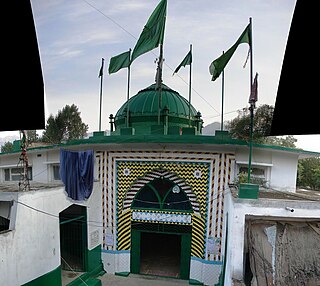The surname Al-Zaidi (Az-Zaidi) can denote one or both of the following:

Sayyid is an honorific title denoting people accepted as descendants of the Islamic prophet Muhammad through his grandsons, Hasan ibn Ali and Husayn ibn Ali, sons of Muhammad's daughter Fatima and his cousin and son-in-law Ali.

The Alids are an Islamic community descended from the fourth caliph Ali. They are split into three branches, the Hasanids, Husaynids and Hanafids, who are the descendants of Ali's sons Hasan, Husayn and Muhammad ibn al-Hanafiyya respectively. The Alids community are found predominantly in the Middle East.
Sadaat-e-Bahera, sometimes pronounced Sadaat-e-Bahara, are a community of Sayyids, originally Elite or Noble Sayyid families situated in the Muzaffarnagar district of Uttar Pradesh in India. This community had considerable influence during the reign of the Mughal Empire. Its members were also found in Karnal District and Haryana, Gujarat & Karnataka, Maharashtra state in India.Some of the members of this community have migrated to Pakistan after independence and have settled in Karachi, Khairpur State in Sind and Lahore. Sadat e Bara or Sayads of Barha or Saadat-e-Barha Saadat Bara/Saiyids of Barha
Sayyid (Arabic: سيد [ˈsæj.jɪd], Persian: [sejˈjed]; meaning 'Lord', 'Master'; plural: Sadat Arabic: سادة sādah is a masculine name given to descendants of the Islamic prophet Muhammad. It is not to be confused with Sa‘id.

Sayyid Ali Tirmizi, more commonly known as Pir Baba, was a Naqvi Sayyid, and a Sufi who settled in Buner among the Yusufzai Pashtuns. He was probably born in 908 AH, in Fergana, of Sayyid descent, died in AH 991. He was a supporter of the Mughal emperor Babar, and was an opponent of Bayazid Pir Roshan.
Ahmad al-Muhajir also known as Al-Imām Aḥmad bin ʻIsa was an Imam Mujtahid and the progenitor of Ba 'Alawi sada group which is instrumental in spreading Islam to India, Southeast Asia and Africa. He was the son of ‘Isa the son Muhammad the son of Ali al-Uraydi who was the fourth son of Imam Ja'far al-Sadiq, a fifth generation descendant of Ali and Fatimah, the daughter of Muhammad.

The Naqvi people are an orthodox Shia community found in Iran, Iraq and South Asia and are descendants of Shia Imam Ali Naqi. Conventionally, Naqvis are Sayyids, who trace their patrilineal descent from Muhammad through his grandson, Husayn ibn Ali.
Sambalhera is an ancient village in Jansath Tehsil of Muzaffarnagar district, Uttar Pradesh, India, 6 km from Jansath town. Chhatraudi branch of Sadat Bahera settled here in the 11th century. Many ancient and medieval tombs of Barha generals are still there.

Amiral Kabir Sayyid Mahmud Khan Barha, also known as Mahmud Khan, was a general in the Akbar's army, son of Sayyid Mubarak, was the first person of this family - the Saiyids of Barah - to rise to the rank of a nobleman. This he did through his bravery and valour during the Timurid Dynasty. He joined the service of Bairam Khan.

Jalaluddin "Surkh-Posh" Bukhari was a Sufi saint and missionary belonging to the Sufi order of Hussaini Jalali.

Wali Kirani was a Muslim saint. His date of birth and date of death are not known, but is believed to have lived around the time of Sultan Hussain Mirza's rule in Herat around 1470.

The Sadaat Amroha or Amrohi SAYYID or SAYYID OF AMROHA(Urdu: امروہی سید) are a community of Sayyids, historically settled in the town of Amroha, in the Indian state of Uttar Pradesh. Many members of the community migrated to Pakistan after independence and settled in Karachi, Sindh.
Ahmad Khan Barha was a powerful general in Mughal Emperor Akbar's army during the 16th century.

Sayyid ul Sadaat Sayyid Mir Jan Shah Saheb ibn Hasan Kabuli-Naqshbandi al Hasani wal-Husseini(Arabic: سيد مير جان شاه صاحب ابن حسن كابلى-نقشبندى) is a Sufi saint from Kabul.
Naqib al-ashraf was a governmental post in various Muslim empires denoting the head or supervisor of the descendants of the Islamic prophet Muhammad. The descendants of Prophet Muhammad were known as ashraf and throughout Islamic history, the ashraf organized themselves into large groups, akin to corporations, throughout the various Muslim territories. This was done to ensure their special place in Muslim society and thus maintain their socio-political privileges.

The Barha Dynasty is an Indian Muslim dynasty of Sayyid origin, descending from the 7th-century AD Caliph, Ali. It is among the largest and oldest royal houses in India and the world, and consists of Abdullah al Wasiti, the founder of the dynasty, and his male-line descendants, who ruled in South Asia from their arrival at the close of the 10th century until the second half of the 20th century. The abolition of Indian Princely States including the Princely State of Rampur ruled by the Rohilla branch of the Barha Dynasty brought their rule to an end.
Sayyid ul Sadaat Sayyid Mir Fazlullah Agha al-Hasani wal-Husseini was a Sufi Saint and the highest Qadi and Grand Mufti of the Emirate of Afghanistan.

Sayyid ul Sadaat Mir Hasan ibn Azimullah was an islamic scholar, Jurist, Sufi Saint, theologian, preacher, noble and leader of the community of the descendants of Prophet Muhammad, respect with the title Sayyid ul Sadaat.









